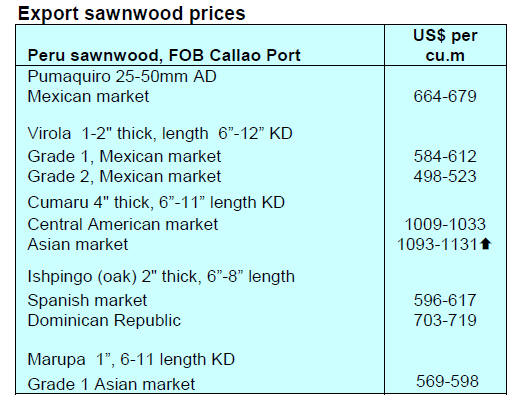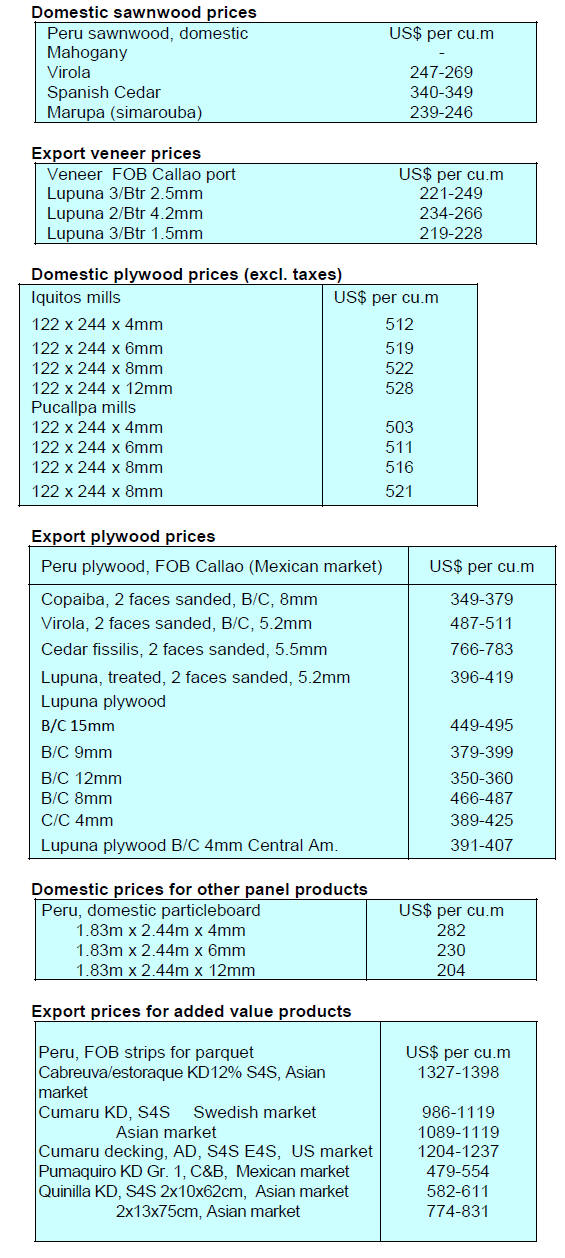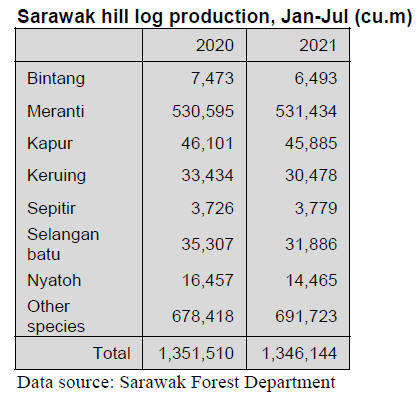
4.
INDONESIA
Shortage of containers disrupting
exports
Indroyono Soesilo, Chairman of the Association of
Indonesian Forest Concessionaires (APHI), has raised the
alarm on rapidly rising shipping costs as this is having an
impact on the export of Indonesia's wood products which
are in high demand. He noted that shipping costs vary but
it is the cost of shipping to the US that is of most concern.
According to Indroyono there solutions such as shipping
using small container ships or vessels to Singapore from
where they on forwarded to the importers. He also said it
is also possible to use small break bulk vessels for direct
export to China
See:
https://newssetup.kontan.co.id/news/kontainer-langkaekspor-produk-industri-kehutanan-nasional-terhambat
Apply health protocols in mills and factories
Acting Director General of Agro Industry in the Ministry
of Industry, Putu Juli Ardika, stated that the health
protocols applied by the wood and furniture processing
industry were well maintained when they visited wood and
furniture processing industry companies in Tangerang
saying work shift arrangements are very good and social
distancing can be achieved in large factories with fewer
workers.
Putu said through these efforts it is hoped that national
manufacturing productivity will be sustained.
See:
https://www.antaranews.com/berita/2351886/kemenperinnilai-prokes-industri-pengolahan-kayu-dan-furnitur-bagus
Indonesia reported fewer than 10,000 new coronavirus
cases and less than 1,000 deaths on 6 September. The
virus has continued to surge in some regions including in
parts of Sumatra, Kalimantan, Sulawesi and remote Papua.
Just over 11% of the population has been fully vaccinated.
Since 15 July the number of cases have fallen. The
recovery rate is also higher than new positive cases.
Meranti dominated log production in 2020
Statistics Indonesia (BPS) data shows that the production
of logs from companies with forest concession in
Indonesia was 5.26 million cu.m in 2020. This was down
around 15% compared to the previous year. Meranti
dominated the log production in Indonesia last year and
totaled 1,643,720 cu.m or 31% of total log production. The
production of red meranti was recorded at 653,490 cu.m
last year, about 13% of total production of logs.
The other main timbers harvested in 2020 were merbau,
acacia and keruing. The production of which was 609,710
cu.m, 500,230 cu.m and 331,440 cu.m respectively.
Over 80% of harvested logs were sold on by logging
companies with the balance being used by integrated
operations.
See:
https://databoks.katadata.co.id/datapublish/2021/08/31/merantimendominasi-produksi-kayu-bulat-indonesia-pada-2020
Indonesian furniture attracted attention at the Las
Vegas Summer Market 2021
Contemporary furniture and Indonesian rattan furniture
successfully attracted US buyers at the August Las Vegas
Summer Market 2021 and manufacturers who exhibited
managed to secure potential orders worth around Rp. 20
billion during their five-day participation in Las Vegas.
See:
https://pressrelease.kontan.co.id/release/furniturkontemporer-dan-rotan-indonesia-berjaya-di-las-vegas-summermarket-2021?page=all
Few community forest owners have ready access to
markets
The growth of community-based forest product businesses
is still very low and many owners in rural areas do not
have ready access to the markets. This was stated by Tri
Nugroho, the Program Director of MFP4
(Multistakeholder Forestry Program Phase 4). To address
this so as to improve the lives of people who depend on
forests MFP4 collaborates with an institution known as the
Market Access Player (MAP) which has can help create
links between community producers and buyers.
See:
https://republika.co.id/berita/ekonomi/pertanian/qycqak456/petani-diorong-untuk-hasilkan-komoditas-bernilai-tinggi
Minister spotlights conservation areas in logging,
pulpwood concessions
Indonesian Environment and Forestry Minister, Siti
Nurbaya, has once again pointed out the importance of
high conservation value (HCV) areas that have been
legally set aside in existing logging and pulpwood
plantation concessions covering an area of nearly 3.9
million hectares.
She emphasised that the HCV areas in logging
concessions and plantations represent an ecological last
resort. "Both these industries remain relatively stable
despite the surging pandemic and played a contributing
part at a certain level when Indonesia managed to move
out of economic recession in the second quarter of this
year," she said. Minister Nurbaya pointed out that HCV
areas are not abandoned areas as there are legal and
sustainability measures for the areas.
See:
https://foresthints.news/minister-spotlights-hcv-areas-inlogging-pulpwood-concessions/
Indonesia-Norway climate and forest partnership
terminated
On 10 September 2021 the Government of Norway
received a formal notification that the Government of
Indonesia had decided to terminate the 2010 Letter of
Intent on Cooperation on Reducing Greenhouse Gas
Emissions from Deforestation and Forest Degradation.
A press release from the Norwegian authorities reads “Our
two nations have for more than a decade collaborated on
reducing greenhouse gas emissions from deforestation and
forest degradation. During this time, Indonesia has become
a world leader in combatting tropical deforestation. A
series of progressive regulations and policies to protect the
nation’s rainforests have been put in place. The results are
impressive.
Over the last four years Indonesia has delivered massive
reductions of deforestation and peatland conversion. This
is a significant contribution to global climate change
mitigation and protection of biodiversity.
Last year, Norway announced a contribution of NOK 530
million to Indonesia for its 2016/2017 deforestation results
in line with the Letter of Intent. The contribution was
intended to be disbursed to Indonesia’s own financial
mechanism, the newly established Indonesian
Environment Fund (IEF). Recently, our two governments
have been engaged in discussions on a legal agreement for
the transfer of the results-based contribution.
Until the termination announcement discussions in this
regard were ongoing and in Norway’s view constructive
and progressing well, within the frameworks set by our
two countries’ regulatory limits. Given our commitments
in the Letter of Intent, and Indonesia’s impressive results,
we were looking forward to supporting Indonesia’s efforts
with similarly significant annual contributions in the years
to come.
The Government of Norway would like to congratulate the
Government of Indonesia with their impressive REDD+
achievements to date. We welcome the Indonesian
Government’s continued leadership on this crucial climate
action agenda, and its continued commitment to deliver on
its emission reduction targets. We have highly appreciated
our collaboration and stand ready to continue supporting –
in mutually agreeable ways – Indonesia’s efforts in
protecting its forests and peatlands”.
See:
https://www.nicfi.no/current/press-statement-the-indonesianorway-climate-and-forest-partnership/
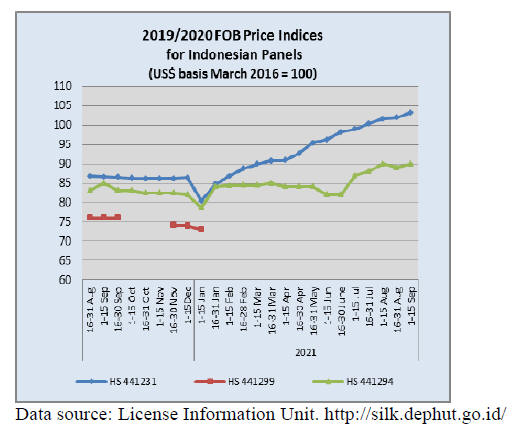
5.
MYANMAR
Sustainable development of wood-based
industry
The recently established Development Committee for the
Wood-Based Industries has initiated a survey of exporters.
This is the first ever comprehensive survey to seek the
perspectives of all players- forest products associations
and the individual manufacturers.
The committee was formed with Deputy Minister as Chair
and Managing Director of the MTE as Secretary. The
terms of the committee are wide ranging and include raw
material sourcing, technology, taxation and regulations.
The survey covers application of HS codes, importation of
raw materials, Forest Department and the Myanma Timber
Enterprise (MTE) documentation, promoting exports of
products other than sawnwood, difficulties in investment
and taxation, market barriers, shipping procedures,
application of forest permit (legality Certificate by Forest
Department) and export licensing by the Trade
Department.
One manufacturer said, in relation to HS codes, Myanmar
and importing countries need to reconcile or synchronise
the codes. In Myanmar, the unit of quantity is either cubic
ton 1 ( cubic ton is 50 cubic-foot) or cubic metre.
Auction of seized timber
According to Irrawaddy Online News, MTE will auction
12,500 tons of hardwood in September as it seeks to raise
hard currency. MTE said the sale includes 1,500 tons of
teak logs and 1,000 tons of sawn teak. The auction will be
held in Yangon’s Insein Township with buyers bidding
online.
In May MTE held three separate auctions when nearly
10,300 tons of timber was sold for around US$5 million
followed by another auction in June of more than 14,000
tons of timber. The wood sold in May and June reportedly
came from a stockpile of 200,000 tons of timber seized by
the previous elected government.
However, a retired Manager of MTE who asked not to be
identified is reported as saying “it was not logical to say
all 200,000 tons of stockpile was illegally harvested. Some
of timbers might not meet the EUTR requirement to be
legal but it was not fair to say that all is illegal”. He also
spoke of his frustration as MTE needs about US$35
million annually to pay salaries and pensions.
In related news, it is reported that the parallel National
Unity government has warned it will blacklist any bidder
and government staff involved in the timber auctions.
See:
https://www.irrawaddy.com/news/burma/myanmar-junta-toauction-over-12000-tons-of-illegal-timber.html
Foreign trade falls sharply
The Ministry of Commerce has reported Myanmar’s
export earnings were just over US$26 billion as of 20
August in the current 2020-2021 fiscal year, a drop of
nearly US$7 billion compared to the same period of last
financial year according to.
In the eight months of the current financial year to May
China topped the list of the 10 countries to which
Myanmar exported goods most.
Myanmar exported goods worth US$3,985.06 million to
China, US$2,091.81 million to Thailand, US$673.87
million to Japan, US$485.50 million to India, US$434.67
million to the US, US$261.71 million to Germany,
US$245.75 million to the UK, US$233.48 million to
Spain, US$203.72 million to the Netherlands and
US$198.29 million to South Korea according to the data
from the commerce ministry.
See:
https://elevenmyanmar.com/news/myanmars-foreign-tradevalue-declines-by-nearly-7-billion-this-year
Exporters told to convert hard currency
The Myanmar Central Bank has told exporters that they
must convert all foreign currency earnings into the
domestic currency within four months of the receipt. The
Bank stated that the earnings in foreign currency from
export which entered their bank accounts must be sold in
four months after the entry to the licensed banks with
current market price without fail.
The Bank rule came into effect the day of the
announcement. The announcement was issued under the
foreign Exchange Management Law, 49 (c).
According to Foreign Exchange Management Law section
38 (b), 42 (a) and 35, all earnings in foreign currency
received in the course of exports must be deposited in
respective local bank accounts within a limited time frame
after the goods have been loaded and shipped.
See:
https://elevenmyanmar.com/news/cbm-exporters-to-sellexport-earnings-in-their-accounts-in-four-months-after-theirentry-into
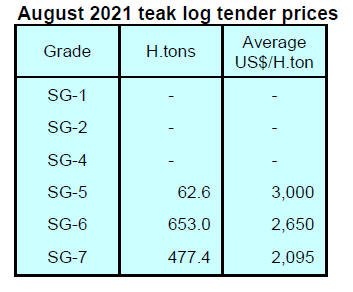
6. INDIA
Corona up date
India administered more than 180 million corona vaccines
doses in August as it continues to speed up its vaccination
programme to try and stall a third wave of infections. The
government aims to vaccinate all eligible Indians by the
end of this year.
It has been reported that India will begin using a new
COVID-19 vaccine that uses circular strands of DNA to
trigger an immune response to the corona vius. This could
be good news as the new DNA vaccine could be used
anywhere in the world when approved. The new vaccine,
ZyCoV-D is administered into the skin without an
injection and has been found 67% effective.
See:
https://www.nature.com/articles/d41586-021-02385-x
Government data showed India’s economy expanded 20%
year-on-year in the April-June quarter. During the same
period last year, India's economy shrank by 24%.
Rising freight charges to dent exports
After the record high in July 2021 Indian exports will be
affected by the shortage of shipping containers around the
world. Export competiveness could be dented as the
rapidly rising costs of shipping are passed on to
consumers.
The cost of shipping a container has more than doubled in
a few months and the Federation of Indian Exporters
Organisation (FIEO) and other private sector groups have
alerted the Central government and urged action.
India’s exports grew to US$33.1 billion in August, 45%
higher than last year, but a faster pace of increase in
imports resulted in trade deficit widening to US$13.9
billion, the highest since April.
Although exports were nearly US$2 billion lower than in
July when they hit US$35.4 billion.
See:
https://www.indiatoday.in/business/story/global-containershortage-impact-on-india-export-trade-volume-1847120-2021-08-30
Rebound in consumer confidence
Indian householder consumer confidence improved almost
3% month on month in August according to the monthly
Refinitiv-Ipsos Primary Consumer Sentiment Index
(PCSI) for India. This index takes account of consumer
attitudes on the current and future state of local
economies, personal finance situations, savings and
confidence to make large investments.
See:
https://www.livemint.com/news/india/consumerconfidence-improves-in-august-11628916022960.html
Demand for wood to surge in India by 2030 - new
report
There will be a substantial increase in wood consumption
in India by 2030, exacerbating an existing shortfall
between wood production and demand and increasing the
country’s reliance on wood imports, according to an ITTO
report that analyzes India’s timber market dynamics to
2030.
The report shows that, although India’s forest cover has
increased steadily for nearly two decades, timber
production is still substantially less than consumption, and
an increasingly large proportion of demand is being met
by imports. The report has three main sections. The first
reviews the development of the Indian forest sector over
the last decade, including changes in forest cover and
timber growing stock.
The second section analyses trends in India’s wood-based
industry, including the international trade of roundwood,
sawnwood, plywood, fibreboard, hoopwood, pulp and
veneer.
The third section of the report provides projections of
demand for 2021–2030, based on likely increases in
population and income, wood consumption trends, and
growth in important wood-based industries. The report
concludes with a discussion on how to improve the
accuracy of future reports.The study forecasts a jump of
nearly 70% in demand for roundwood in India in the next
decade, from 57 million cu.m in 2020 to 98 million
cu.m in 2030, driven largely by the construction sector.
Without policy change, say the authors, India will need to
rely heavily on imports to meet this surge in demand
because domestic production is restricted by the country’s
conservation-oriented forest policy.
See:
https://www.itto.int/other_technical_reports/

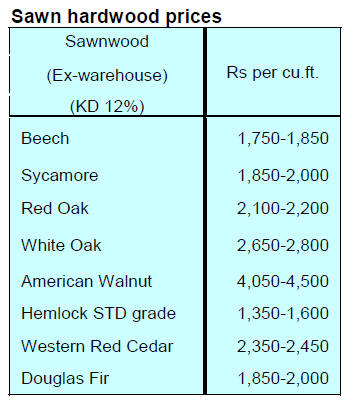
Plywood
Plywood prices have been raised once again as production
costs have jumped. MDF and particleboard manufacturers
(and to some extent, plywood makers) share the same
domestic wood raw material base and competition for raw
materials is becoming intense resulting in rapid increases
in prices.
In addition, resin costs are rising. Much of the resin and
other chemicals used in production are imported and rising
freight costs and rising global demand has pushed up
prices. Adding to the problems faced by wood based panel
makers is the shortage of workers and consequent increase
in wages.
Mills in Kerala relied on experienced workers from Assam
and mills in Maharashtra relied on workers from Orissa.
Workers from these two regions fled the cities during the
worst of the pandemic and have been slow to return.
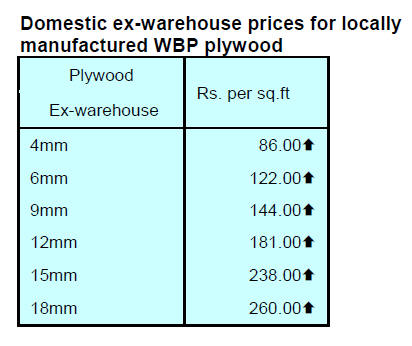
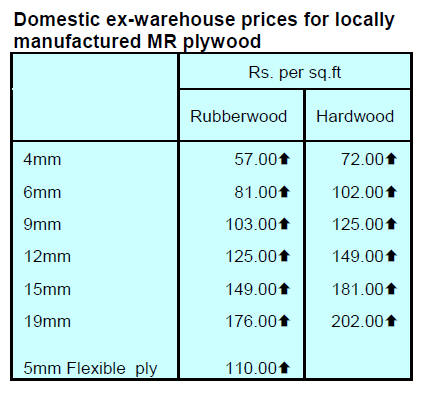
7.
VIETNAM
Two scenarios for Vietnams’ exports in the last
months of 2021
In the first two quarters of 2021 exports of wood and wood
products from Vietnam increased but due to the pandemic
export earnings will decline in the coming months.
According to the Directorate of Customs exports of wood
and wood products in the first 7 months of 2021 reached
US$9.26 billion, a 57% increase compared to the same
period of 2020.
However, since July social distancing and restrictions on
movement in many provinces and cities in Vietnam have
impacted production. Exports of wood and wood products
in July reached nearly US$1.3 billion, some 17% down
year on year. In the first half of August export earning fell
45% compared to July.
It is possible that covid restrictions will be in place for
sometime and this will badly affect production. Covid-19
control measures affect all sector of the timber industry,
especially companies in the main wood processing centers
like Binh Duong, Dong Nai Provinces and Ho Chi Minh
City.
The response of companies to the recent lockdown has
been to reduce the number of workers and reduce or
curtail production. Some companies are trying to maintain
production at 20 - 50% of capacity in order to partially
meet orders and maintain jobs for employees. Workers
from plants that have stopped production are facing an
uncertain future.
A recent survey conducted in Ho Chi Minh City, Binh
Duong Province and Dong Nai Province by three
associations including the Handicraft and Wood
IndustryAssociation of Ho Chi Minh City (HAWA), Binh
Duong Furniture Association (BIFA) and Dong Nai Wood
and Handicraft Association (DOWA) revealed some
alarming data. By August 18.5% of association members
halted production, 46% of members reduced the capacity
and applied the “3 on-site” rule.
It was estimated that over 80% of workers in the
association member plants had temporarily lost their jobs.
A study conducted jointly by Forest Trends, VIFOREST
and the Forest Products Association of Binh Dinh
Province set out two possible scenarios for export in the
last months of this year.
In the first scenario the group assumed the decline in the
first half of Auguts will last to the end of the third quarter.
By that time the vaccination roll-out will be well
underway.
As a result export earnings will begin to recover from the
fourth quarter but would only be around 70% of the first
two quarter earnings. If accurate the gross wood product
earnings for 2021 will be US$13.55 billion.
In the second scenario the group assumed the pandemic
will not be controlled so in this case the decline in export
earnings will continue until year end such that 2021
earnings would be only US$12.69 billion.
See:
https://vietnamagriculture.nongnghiep.vn/2-scenarios-ofwood-exporting-of-vietnam-in-the-last-coming-months-of-2021-d301443.html
Enterprises starved of raw materials and workers
Timber enterprises in Binh Dinh have a huge backlog of
export orders but there is a severe shortage of workers and
raw materials and the supply chain has been disrupted.
According to Le Minh Thien, Chairman of Binh Dinh FPA
thanks to the USA, EU, UK and Australia markets
enthusiastically import furniture from the beginning of
2021 until the end of August furniture manufacturers in
Binh Dinh have exported a wide variety of products
through online channels.
However, now a number of localities in Binh Dinh
Province have to comply with the Government's Directive
16 for Covid-19 prevention and control. The restriction on
the movement of people has forced many wood processing
businesses in the area to stop operating.
He also said if this situation persists throughout September
furniture exports from Binh Dinh manufacturers will
plummet by 30-40% compared to July and the situation
will be even more severe in October.
According to the Binh Dinh FPA several large furniture
factories in Binh Dinh have implemented the ‘3 on the
spot’ system to maintain production. However, businesses
can only sustain this for a short time because the costs
incurred are too high and regular screening is costly and
time consuming.
Assuming an enterprise has 500 workers working "3 on
the spot", a test for all workers will cost about VND 70
million. In one month, four tests are required.
Implementing this ‘3 on the spot’ system creates other
problems as workers still face difficulties when going
through quarantine checkpoints. Many localities have
become too worried and applied strict measures to prevent
people from going to work in order to manage prevention
and control measures. It was not until FPA Binh Dinh
raised this with local authorities that workers could go
travel to work.
Wood processing enterprises in Binh Dinh have to face
another difficulty, the supply of raw materials. The
‘furniture capitals’ of Binh Duong and Dong Nai are now
paralysed and supply chains are broken. This has pushed
up the price of timber raw materials.
See:
https://vietnamagriculture.nongnghiep.vn/wood-enterprisestarve-of-materials-and-workers-d302066.html
Vietnams’ W&WP trade in the first 7 months of 2021
Exports
In the first 7 months of 2021 W&WP exports reached
US$9.26 billion, up 54% over the same period of 2020.
Due to the severe outbreak of Covid-19 in the major wood
processing industries of Binh Duong, Dong Nai and Ho
Chi Minh City exports in July dropped by 17% compared
to June. On the other hand imports of W&WP in the first 7
months were valued at US$1.81 billion, a year-on-year
increase of 39%.
W&WP exports to top markets in the first 7 months of
2021 are as follows:
US: US$5.72 billion, up 77.4%, accounting for
62% of Vietnam's W&WP exports;
Japan: US$0.81 billion, up 18.8%, sharing 9% of
the total W&WP exports;
China: US$0.93 billion, up 24.8%, equivalent to
10% of the total exports;
South Korea: US$0.53 billion, up 16.8%, taking
6% of the total exports;
EU: US$0.38 billion, up 34.0%, 4% of the total
value of G&SPG exports;
UK: US$0.16 billion, up 29.4%, contributing 2%
of the total exports;
Canada: US$0.15 billion, up 48.9%, about 2 per
cent of total exports.
Exports of the major W&WP including indoor/outdoor
furniture, seats, woodchip, woodpellet, veneer (peeling),
particle-board, fiber-board, plywood/finger-joint wood in
the first 7 months of 2021 increased as follows:
Furniture: US$4.33 billion, up 53% over the same
period in 2020;
Wooden seats: US$2.35 billion, up 99%;
Woodchip: US1.08 billion (8.5 million tonnes),
up 23% in volume and 17% in value;
Plywood/finger-joint wood: US$570.47 million
(1.54 million cu.m), up 43% in volume and 99%
in value;
Wood-pellet: US$241.22 million (2.14 million
tonnes), up 32% in volume and 36% in value;
Veneer (peeling): US$117.32 million (1.21
million cu.m), up 337% in volume and 185% in
value;
Fibreboard: US$36.75 million (66,860 cu.m), up
1.4% in volume and 46% in value;
Particleboard: US$6.30 million (29,870 cu. m),
up 19% in volume, but down by 3% in value.
Of wooden furniture exports of kitchen cabinets (HS
9403.40) continued up growing over 60% compared to the
same period of the last year. Next to kitchen cabinets are
upholstered seats where exports more than doubled to
US$1.50 billion.
Imports
Vietnam imported US$1.81 billion of W&WP in the first 7
months of 2021, up 39% against the same period of 2020.
Sawnwood, logs, veneer, fibreboard, plywood, wooden
seats and furniture were the main imports.
W&WP are imported from 113 countries/territories in the
first 7 months of 2021. China, the US, Cameroon,
Thailand and Chile are 5 top sources with the supply of
US$1.12 billion, accounting for 62% of the total value of
W&WP imports into Vietnam.
China:
The value of W&WP imports from this market reached
US$667.23 million, up 71% over the same period in 2020,
accounting for 37% of the total value of imports from all
sources.
Major imports from China include plywood (US$153.08
million), Veneer (US$140.10 million), wooden seats
(US$107.03 million) and furniture (US 91.37 million).
US:
W&WP imports from the US were valued at US$189.67
million, accounting for 10.5% of total imports, up 2% in
value. The US exports mainly logs (130,370 cu.m) and
sawnwood (291,580 cu m). The US is the top sawnwood
suppliers for Vietnam.
Cameroon:
Over the first 7 months of 2021 imports from Cameroon
amounted to US$112.47 million, down 10% compared to
the same period in 2020 and contributed 6% of the total
imports. Logs (177,700 cu.m) and sawnwood (90,500
cu.m) are imported from Cameroon.
Thailand:
Imports from Thailand reached US$0.43 million in the
first 7 months of 2021, up 68%, accounting for 5% of the
imports from all sources. Particleboard (108,550 cu.m),
fibreboard (257,570 cu.m) were the key products imported
from Thailand.
Chile:
Imports were worth US$58.31 million, up 62%,
accounting for 3.2% of the total imports. Sawnwood was
the main product Vietnam imported from Chile (210,230
cu.m)
8. BRAZIL
Combating environmental crimes in the
Amazon
The Brazilian Federal Government is making efforts to
reduce the incidence of environmental crimes. The
Brazilian Institute for Environment and Renewable
Natural Resources (IBAMA) and the Chico Mendes
Institute for Biodiversity Conservation (ICMBio), the
Armed Forces and the National Public Security Force have
been working together in the Amazon region.
In June this year the Federal Government announced a
new operation called the Samaúma Operation which will
specifically address illegal deforestation. The operation is
being conducted in 26 municipalities in the States of Pará,
Amazônia, Rondônia and Mato Grosso, which together
account for around 70% of environmental offenses in the
Legal Amazon.
The Samaúma Operation is coordinated by the National
Council of the Legal Amazon (CNAL), chaired by the
Vice President. This operation can authorise the use of the
Armed Forces in indigenous lands, federal environmental
conservation units, federal land areas in general and upon
request of State Governors in areas of the states covered
by the operation.
Partnership to promote development of the timber
sector
The state of Mato Grosso is one of the main tropical
timber producing states in Brazil and the Timber Industry
Union of Northern Mato Grosso State (SINDUSMAD) in
partnership with the National Service for Industrial
Training (SENAI) is to offer training courses for its
employees aimed at further the development of the timber
sector. According to SENAI companies should benefit
from improved productivity and competitiveness.
Improving world economy lifts timber exports
Driven by the economic recovery in the world's largest
economies exports from Paraná State totalled US$1.8
billion in July, 11% more compared than in July 2020.
Between January and July this year exports from Paraná
have grown 14% year on year.
Wood products are one of the main products exported
from the state and earnings reached US$1.1 billion
according to the Foreign Trade Secretariat, Ministry of
Economy. The strong recovery in developed economies
explains the more than doubling of furniture exports.
Almost 60% of the wood products exported from Paraná
State are for the US market.
The appreciation of the US dollar against the Brazilian
currency favors exports making the Brazilian product
more competitive in international markets. Brazilian
furniture exports closed the first half of 2021 with a 72%
increase compared to the same period in 2020. The main
importers were the US followed by Chile and the United
Kingdom. Furniture manufacturers in Brazil have been
adopting ‘green’ manufacturing using sustainably
produced timber along with recycled wood.
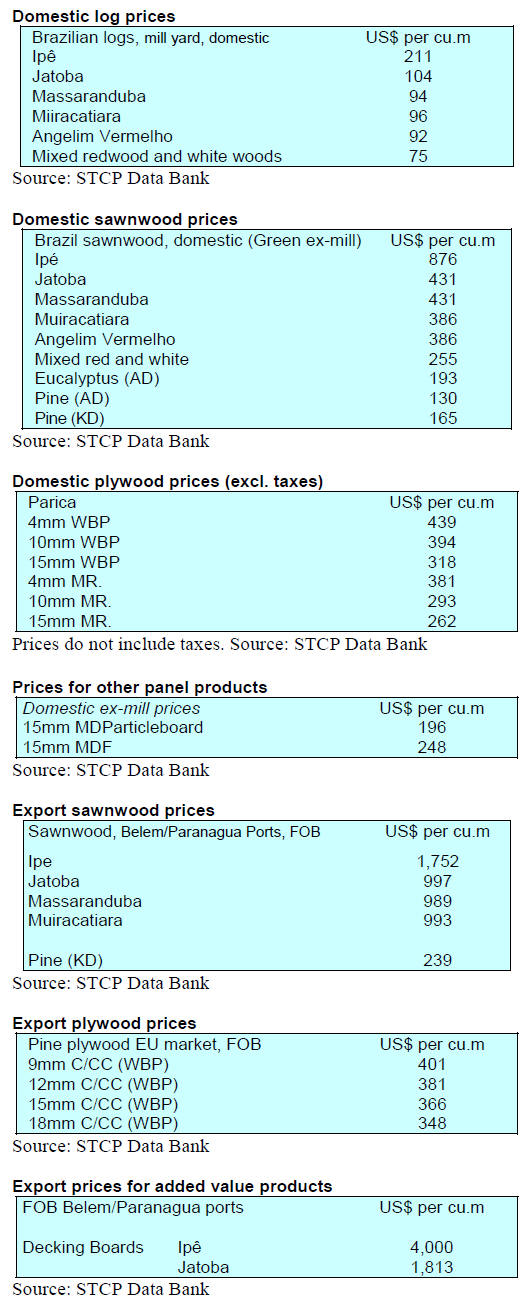
9. PERU
Osinfor improves information system
The Forest Resources and Wildlife Supervision Agency
(Osinfor) has made changes to its Management
Information System (SIGO sfc v3.0) to provide more
information on the use of natural resources.
With the technical support of USAID and the United
States Forest Service this new version of the SIGO sfc
contains improved internal management for the inspection
processes and is expanded to include additional public
entities to strengthen traceability. The traceability report
provides detailed information on the location of the site,
expiration of permits, management plan, species and
approved volume among other items. It also covers
supervision, auditing and training.
The manager of the Forest Program of USAID and the
United States Forest Service, Victor Miyakawa, welcomed
Osinfor's initiative to continuously improve its processes
as he considers these improvements in the SIGO sfc will
provide key information to boost the competitiveness in
the forest sector.
US company in violation of Lacey Act
A US company has pleaded guilty in the District of
Columbia to violating the Lacey Act. The company
admitted that it failed to exercise due care when it
imported timber from the Peruvian Amazon. The court
imposed a fine of US$5,000 and ordered a US$200,000 in
restitution to the Ministry of Environment of Peru.
Peru issues documents to establish the chain of custody
and ensure that any timber harvested or transported is
legal. The Agency for Supervision of Forest Resources
and Wildlife (OSINFOR) audits harvest sites to ensure
legal compliance.
OSINFOR makes its findings available on SIGO, an opensource
website maintained by the Peruvian government.
Importers are able to check SIGO to determine if there
have been any irregularities regarding specific harvest
permits.
The Trade Enforcement Group of Homeland Security
Investigations in Houston and CBP conducted the
investigation with assistance from Peruvian authorities.
Trial Attorneys Patrick Duggan and Ryan Connors of the
Environmental Crimes Section of the Environment and
Natural Resources Division prosecuted the case.
See:
https://www.justice.gov/opa/pr/us-corporation-sentencedimporting-illegally-sourced-wood-amazon
